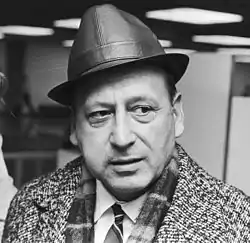Angelo Niculescu
Angelo Niculescu (1 October 1921 – 20 June 2015) was a Romanian football player and manager.[1][2][3] He was the coach of the Romania national football team during the 1970 FIFA World Cup. He is best remembered in Romania for inventing the "temporizare" ("delaying") tactics in which the team keeps the possession of the ball inside its own half and the players are using many short passes from one side to another of the field in order to disrupt the opponents patience when they go out of their field to make pressing; this is also known as tiki-taka.[4] With such tactics Romania qualified for a World Cup after more than 30 years and registered a win against Czechoslovakia.
 Niculescu in 1970 | |||
| Personal information | |||
|---|---|---|---|
| Full name | Angelo Niculescu | ||
| Date of birth | 1 October 1921 | ||
| Place of birth | Craiova, Romania | ||
| Date of death | 20 June 2015 (aged 93) | ||
| Place of death | Bucharest, Romania | ||
| Position(s) | Midfielder | ||
| Youth career | |||
| 1937–1939 | Rovine Grivița Craiova | ||
| Senior career* | |||
| Years | Team | Apps | (Gls) |
| 1939–1944 | FC Craiova | ||
| 1945–1947 | Carmen București | ||
| 1947–1948 | Ciocanul București | 29 | (1) |
| 1948–1950 | Dinamo București | 33 | (0) |
| Teams managed | |||
| 1953 | Dinamo București | ||
| 1954 | Dinamo București | ||
| 1955–1957 | Dinamo București | ||
| 1958 | Steaua București | ||
| 1958–1959 | Tractorul Brașov | ||
| 1964–1965 | Dinamo București | ||
| 1965–1966 | Dinamo București | ||
| 1967–1972 | Romania | ||
| 1973–1977 | Sportul Studențesc | ||
| 1977–1979 | Politehnica Timișoara | ||
| 1979–1980 | Dinamo București | ||
| 1980–1981 | SC Bacău | ||
| 1981–1982 | Universitatea Cluj | ||
| 1983–1984 | Oțelul Galați | ||
| * Senior club appearances and goals counted for the domestic league only | |||
References
- "Sfârșitul echipei Ciocanul". RomanianSoccer. Retrieved 9 February 2020.
- "Dinamo Bucuresti in 1949". RomanianSoccer. Retrieved 9 February 2020.
- "Dinamo Bucuresti in 1950". RomanianSoccer. Retrieved 9 February 2020.
- Crăiţoiu, Andrei. "Foștii elevi îl omagiază pe Angelo Niculescu: "A fost cel mai mare antrenor al României!"". Gazeta Sporturilor (in Romanian). Retrieved 27 January 2016.
External links
| Wikimedia Commons has media related to Angelo Niculescu. |
- Report about Angelo Niculescu
- News at frf.ro about Niculescu's death
- Angelo Niculescu player profile at Labtof.ro
- Angelo Niculescu manager profile at Labtof.ro
This article is issued from Wikipedia. The text is licensed under Creative Commons - Attribution - Sharealike. Additional terms may apply for the media files.